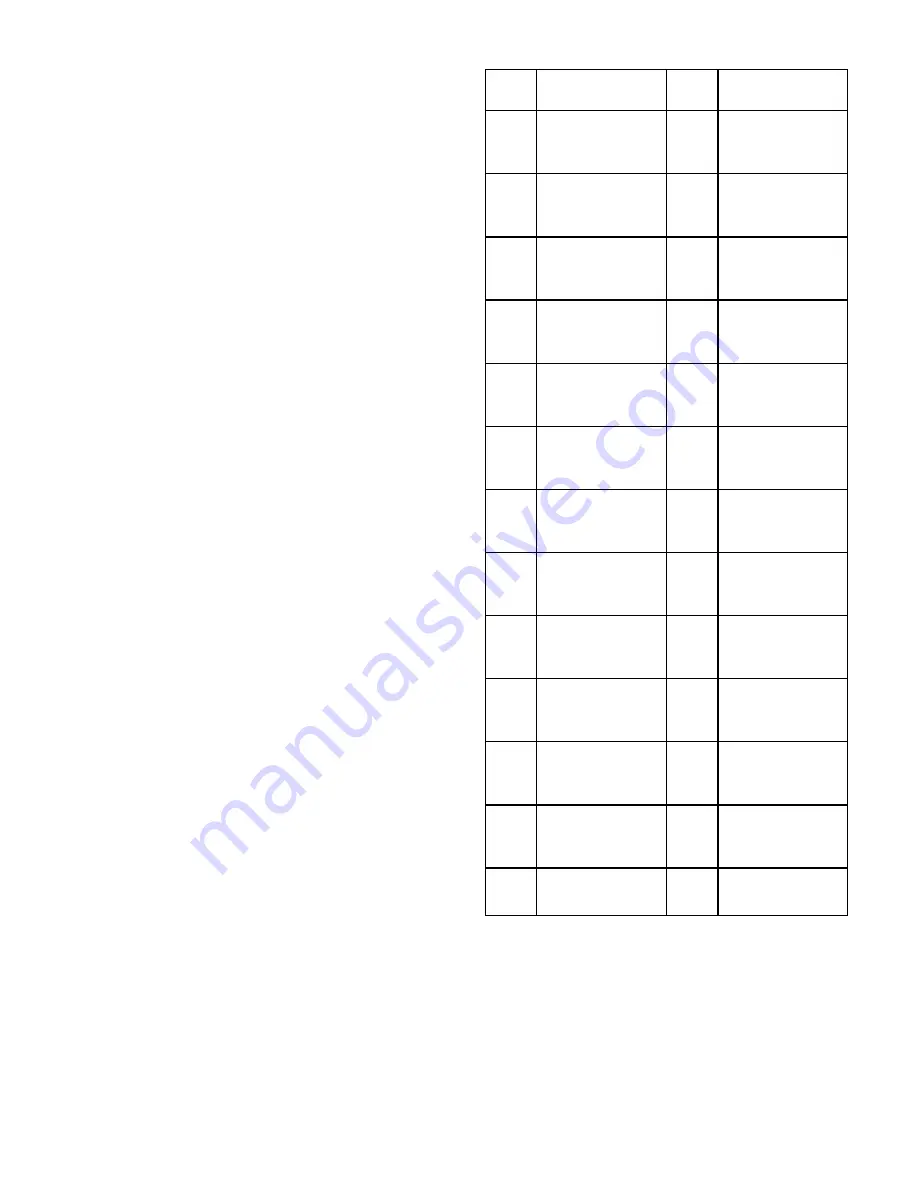
SERVICING
42
2. Install a high side pressure gauge on the high side service
valve.
3. Record the gauge pressure and the temperature of the line.
4. Convert the discharge pressure gauge reading to tempera-
ture by finding the gauge reading in Temperature - Pres-
sure Chart and reading to the left, find the temperature in
the °F. Column.
5. The difference between the thermometer reading and pres-
sure to temperature conversion is the amount of subcool-
ing.
EXAMPLE:
a. Discharge Pressure = 260
b. Corresponding Temp. °F. = 120°
c. Thermometer on Liquid line = 109°F.
To obtain the amount of subcooling subtract 109°F from 120°F.
The difference is 11° subcooling. The normal subcooling range
is 14° - 18°.
S-110 CHECKING EXPANSION VALVE OPERA-
TION
1. Remove the remote bulb of the expansion valve from the
suction line.
2. Start the system and cool the bulb in a container of ice
water, closing the valve. As you cool the bulb the suction
pressure should fall and the suction temperature will rise.
3. Next warm the bulb in your hand. As you warm the bulb
the suction pressure should rise and the suction tempera-
ture will fall.
4. If a temperature or pressure change is noticed, the expan-
sion valve is operating. If no change is noticed, the valve is
restricted, the power element is faulty, or the equalizer
tube is plugged.
5. Remove the charge, replace the valve and drier, evacuate
and recharge.
S-111 FIXED ORIFICE RESTRICTION DEVICES
The fixed orifice restriction device (flowrator) used in conjunc-
tion with the indoor coil is a predetermined bore (I.D.).
It is designed to control the rate of liquid refrigerant flow into an
evaporator coil.
The amount of refrigerant that flows through the fixed orifice
restriction device is regulated by the pressure difference be-
tween the high and low sides of the system.
Temp.
°F.
Gauge Pressure
(PSIG) Freon-22
Temp.
°F.
Gauge Pressure
(PSIG) Freon-22
-40
-38
-36
-34
0.61
1.42
2.27
3.15
60
62
64
65
102.5
106.3
110.2
114.2
-32
-30
-28
-26
4.07
5.02
6.01
7.03
68
70
72
74
118.3
122.5
126.8
131.2
-24
-22
-20
-18
8.09
9.18
10.31
11.48
76
78
80
82
135.7
140.5
145.0
149.5
-16
-14
-12
-10
12.61
13.94
15.24
16.59
84
86
88
90
154.7
159.8
164.9
170.1
-8
-6
-4
-2
17.99
19.44
20.94
22.49
92
94
96
96
175.4
180.9
186.5
192.1
0
2
4
6
24.09
25.73
27.44
29.21
100
102
104
106
197.9
203.8
209.9
216.0
8
10
12
14
31.04
32.93
34.88
36.89
108
110
112
114
222.3
228.7
235.2
241.9
16
18
20
22
38.96
41.09
43.28
45.53
116
118
120
122
248.7
255.6
262.6
269.7
24
26
28
30
47.85
50.24
52.70
55.23
124
126
128
130
276.9
284.1
291.4
298.8
32
34
36
38
57.83
60.51
63.27
66.11
132
134
136
136
306.3
314.0
321.9
329.9
40
42
44
46
69.02
71.99
75.04
78.18
140
142
144
146
338.0
346.3
355.0
364.3
48
50
52
54
81.40
84.70
88.10
91.5
158
150
152
154
374.1
384.3
392.3
401.3
56
58
95.1
98.8
156
158
160
411.3
421.8
433.3
TEMPERATURE - PRESSURE (R-22)
In the cooling cycle when the outdoor air temperature rises,
the high side condensing pressure rises. At the same time,
the cooling load on the indoor coil increases, causing the low
side pressure to rise, but at a slower rate.

![Preview for 28 page of Goodman [A/G]PG Service Instructions Manual](http://thumbs.mh-extra.com/thumbs/goodman/a-g-pg/a-g-pg_service-instructions-manual_2243406-28.webp)
![Preview for 29 page of Goodman [A/G]PG Service Instructions Manual](http://thumbs.mh-extra.com/thumbs/goodman/a-g-pg/a-g-pg_service-instructions-manual_2243406-29.webp)
![Preview for 30 page of Goodman [A/G]PG Service Instructions Manual](http://thumbs.mh-extra.com/thumbs/goodman/a-g-pg/a-g-pg_service-instructions-manual_2243406-30.webp)
![Preview for 31 page of Goodman [A/G]PG Service Instructions Manual](http://thumbs.mh-extra.com/thumbs/goodman/a-g-pg/a-g-pg_service-instructions-manual_2243406-31.webp)
![Preview for 32 page of Goodman [A/G]PG Service Instructions Manual](http://thumbs.mh-extra.com/thumbs/goodman/a-g-pg/a-g-pg_service-instructions-manual_2243406-32.webp)
![Preview for 33 page of Goodman [A/G]PG Service Instructions Manual](http://thumbs.mh-extra.com/thumbs/goodman/a-g-pg/a-g-pg_service-instructions-manual_2243406-33.webp)
![Preview for 34 page of Goodman [A/G]PG Service Instructions Manual](http://thumbs.mh-extra.com/thumbs/goodman/a-g-pg/a-g-pg_service-instructions-manual_2243406-34.webp)
![Preview for 35 page of Goodman [A/G]PG Service Instructions Manual](http://thumbs.mh-extra.com/thumbs/goodman/a-g-pg/a-g-pg_service-instructions-manual_2243406-35.webp)
![Preview for 36 page of Goodman [A/G]PG Service Instructions Manual](http://thumbs.mh-extra.com/thumbs/goodman/a-g-pg/a-g-pg_service-instructions-manual_2243406-36.webp)
![Preview for 37 page of Goodman [A/G]PG Service Instructions Manual](http://thumbs.mh-extra.com/thumbs/goodman/a-g-pg/a-g-pg_service-instructions-manual_2243406-37.webp)
![Preview for 38 page of Goodman [A/G]PG Service Instructions Manual](http://thumbs.mh-extra.com/thumbs/goodman/a-g-pg/a-g-pg_service-instructions-manual_2243406-38.webp)
![Preview for 39 page of Goodman [A/G]PG Service Instructions Manual](http://thumbs.mh-extra.com/thumbs/goodman/a-g-pg/a-g-pg_service-instructions-manual_2243406-39.webp)
![Preview for 40 page of Goodman [A/G]PG Service Instructions Manual](http://thumbs.mh-extra.com/thumbs/goodman/a-g-pg/a-g-pg_service-instructions-manual_2243406-40.webp)
![Preview for 41 page of Goodman [A/G]PG Service Instructions Manual](http://thumbs.mh-extra.com/thumbs/goodman/a-g-pg/a-g-pg_service-instructions-manual_2243406-41.webp)
![Preview for 42 page of Goodman [A/G]PG Service Instructions Manual](http://thumbs.mh-extra.com/thumbs/goodman/a-g-pg/a-g-pg_service-instructions-manual_2243406-42.webp)
![Preview for 43 page of Goodman [A/G]PG Service Instructions Manual](http://thumbs.mh-extra.com/thumbs/goodman/a-g-pg/a-g-pg_service-instructions-manual_2243406-43.webp)
![Preview for 44 page of Goodman [A/G]PG Service Instructions Manual](http://thumbs.mh-extra.com/thumbs/goodman/a-g-pg/a-g-pg_service-instructions-manual_2243406-44.webp)
![Preview for 45 page of Goodman [A/G]PG Service Instructions Manual](http://thumbs.mh-extra.com/thumbs/goodman/a-g-pg/a-g-pg_service-instructions-manual_2243406-45.webp)
![Preview for 46 page of Goodman [A/G]PG Service Instructions Manual](http://thumbs.mh-extra.com/thumbs/goodman/a-g-pg/a-g-pg_service-instructions-manual_2243406-46.webp)
![Preview for 47 page of Goodman [A/G]PG Service Instructions Manual](http://thumbs.mh-extra.com/thumbs/goodman/a-g-pg/a-g-pg_service-instructions-manual_2243406-47.webp)
![Preview for 48 page of Goodman [A/G]PG Service Instructions Manual](http://thumbs.mh-extra.com/thumbs/goodman/a-g-pg/a-g-pg_service-instructions-manual_2243406-48.webp)
![Preview for 49 page of Goodman [A/G]PG Service Instructions Manual](http://thumbs.mh-extra.com/thumbs/goodman/a-g-pg/a-g-pg_service-instructions-manual_2243406-49.webp)
![Preview for 50 page of Goodman [A/G]PG Service Instructions Manual](http://thumbs.mh-extra.com/thumbs/goodman/a-g-pg/a-g-pg_service-instructions-manual_2243406-50.webp)
![Preview for 51 page of Goodman [A/G]PG Service Instructions Manual](http://thumbs.mh-extra.com/thumbs/goodman/a-g-pg/a-g-pg_service-instructions-manual_2243406-51.webp)
![Preview for 52 page of Goodman [A/G]PG Service Instructions Manual](http://thumbs.mh-extra.com/thumbs/goodman/a-g-pg/a-g-pg_service-instructions-manual_2243406-52.webp)










![Roberts Gorden Combat UHD[S] 150-400 Specifications preview](http://thumbs.mh-extra.com/thumbs/roberts-gorden/combat-uhd-s-150-400/combat-uhd-s-150-400_specifications_1469644-1.webp)






